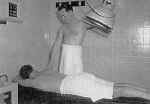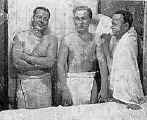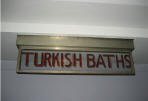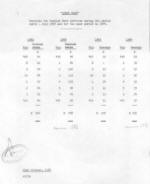 The White Star Line, under whose aegis construction of the liner began, had earlier installed Turkish baths on the
Olympic and the Titanic (1910 and 1911). The Hamburg-built German liner Imperator, which also included Turkish baths, was transferred to the White Star Line after World War I (as compensation for the sinking of the Lusitania) and put into service as
RMS Berengaria in 1919. It must, therefore, have seemed only natural for the company to provide such baths in their new liner, No.534, to be known as RMS Queen Mary.
The White Star Line, under whose aegis construction of the liner began, had earlier installed Turkish baths on the
Olympic and the Titanic (1910 and 1911). The Hamburg-built German liner Imperator, which also included Turkish baths, was transferred to the White Star Line after World War I (as compensation for the sinking of the Lusitania) and put into service as
RMS Berengaria in 1919. It must, therefore, have seemed only natural for the company to provide such baths in their new liner, No.534, to be known as RMS Queen Mary.
The Turkish baths were to be situated on C Deck, between frames 208 and 2271 the main entrance being opposite the First Class dining room, with a second smaller doorway leading off the balcony of the two-deck-high swimming pool. The company had allowed for a probable cost of £5,800.2
Seven companies tendered quotations for constructing the Turkish baths suite. They included such well-known names as Hampton & Sons, and Waring & Gillow, with quotations ranging from £3,845 to £5,150, excluding the costs of the electric bath, massage slabs, and scales. It was decided to accept the tender of Trollope & Sons, even though it was £205 above the lowest quote. They had already won the tender for the adjacent swimming pool and it was hoped that being able to build both facilities would simplify the construction process.
The frigidarium, a large room (35x20ft) for undressing before the bath, and resting and dressing after it, had eight cubicles with large plush curtains which could be pulled across for privacy. Each was fitted with a relaxation slab and a locker with hangers. A ninth cubicle housed an electric bath—a large box through which only the bather's head protruded—similar to the cabinet baths designed for home use at the end of the nineteenth century, but heated by electricity.
From the frigidarium, bathers progressed down a long corridor with a drinking fountain towards the tepidarium, fitted with two resting slabs and a Russian steam bath.3 There followed a similar sized but hotter room, the caldarium and, at the end, the smallest of the three rooms, roughly 7ft square, the laconicum. This was the hottest of the rooms with only a single resting slab.4 All the hot rooms had artificial pearl ceilings and glass windows in their doors so that attendants could check if anyone seemed unwell. Room temperatures ranged from 80ºF to 200ºF.
Initially, there had been complaints that the freshness of the hot air in the earlier liner, Olympic, was not all it should be, but considerable advances had been made in heating technology in the decades which followed, and the equipment installed by Richard Crittall & Co was much better.5
Clean vapour was supplied to the Queen Mary steam room through a specially designed stainless steel diffusion pipe. In the caldarium and laconicum, the patent hot air heaters were supplemented by radiant heat panels.
The air is delivered to the rooms through a system of ducts, and in the ceiling are fixed Stylovent air diffusers, which combine the ability to handle large volumes of air without draught with a dignified and pleasant appearance, completely in harmony with the general scheme of decoration.
The whole of the duct system is controlled by dampers in the plant room, so that the amount of air to be re-circulated or extracted may be varied as required.
The maintenance of the correct temperatures is ensured by electrically operated magnetic valves and thermostats.
The massage room had two Pilkington armour plated glass massage slabs, together with wash-basins and a shower. Completing the suite was an office for the attendant, and a further room in which bathers could obtain ultra-violet, infrared, or diathermy treatments under the supervision of the nursing sister or dispenser.

John Dempsey adjusts the
sun lamp
in the electro-therapy room
When the Queen Mary left on her maiden voyage, the Turkish baths were run by Arthur Mason, who had been specially transferred from the Berengaria.3 His first assistant was a young boxer named Eddie Vincent. However, after a few return trips, Vincent was replaced by Mason's old assistant, John Dempsey. The Turkish baths proved to be very popular with passengers and, after a short time, a third assistant, Harry Leather, had to be appointed.

Harry Leather, John Dempsey, and Arthur Mason, Turkish bath attendants on the Queen Mary, in the steam room
During World War II, the Queen Mary was requisitioned as a troop carrier. By that time the Turkish baths had already been patronized by many famous Cunard White Star passengers. Amongst whom were the Czech Foreign Minister, Jan Masaryk; Viennese operatic tenor Richard Tauber; from the film world, Errol Flynn, Sam Goldwyn, Louis B Mayer, Gabriel Pascal, Robert Taylor and Jack Warner; and boxers Joe Baski, Kid Berg and Tommy Farr.
For some years after the post-war refit and re-launch in 1946, it seemed as though things would soon be back to normal. Indeed, the fifties have been described as the golden years for Cunard.
 Following the practice prevailing on other liners with Turkish baths, there were separate sessions for male and female passengers. As was so often the case in public baths, the hours were not evenly distributed, but whether this was actually because fewer women wished to take
advantage of the facilities, or for some other reason,
is not clear from the few usage figures available.
Following the practice prevailing on other liners with Turkish baths, there were separate sessions for male and female passengers. As was so often the case in public baths, the hours were not evenly distributed, but whether this was actually because fewer women wished to take
advantage of the facilities, or for some other reason,
is not clear from the few usage figures available.
This 'golden' age was not to last as many of those who had traditionally sailed the Atlantic began to take to the air instead. Already at the beginning of the 1960s, leisurely crossing of the Atlantic by sea was in decline, increasingly affected by the growing popularity of jet air travel. Passenger numbers fell and Cunard began seriously to examine the costs of every aspect of their liner operation.
The financial return on the provision of Turkish baths on the Caronia and the two Queens must have made dismal reading. On the Queen Mary, a Turkish bath with an alcohol rub cost ten shillings. A bath and rub on each of the three full days of the voyage could be taken for a ticket costing only £1.5.0.6

Photo: James
A memorandum from the Cunard General Manager's Office, dated 6 May 1963, noted that on the Queen Mary, the cost of the Turkish baths staff—two males, one female, and a boy—exceeded the receipts by £2,298.5.0. This was a considerable loss, and more than that being made on the slightly newer Queen Elizabeth.7
An analysis of the previous year's voyage receipts showed that on the Queen Mary, able to accommodate 776 Cabin Class passengers, the average number of 'treatments' given per sailing day was only 10.7, or three less per day than the Queen Elizabeth.
The writer, Mr T Laird, asked whether any overtime was being worked and suggested that if the staffing could be reduced by one person, and the charges to the passengers raised, then the service 'might be put on a profitable basis'.

A statement of receipts from Turkish baths taken and massages given, for the periods April to July 1963 and 1964, was sent to head office in October 1964, and the decline in overall takings was shown to have continued.8
It is not known whether any changes were made to the level of staffing or to the basic price of a Turkish bath, but by this time Cunard must already have been considering whether to continue the liner in service after the launch of their planned new liner, the QE2.